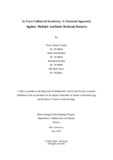| dc.contributor.advisor | Hossain, M. Mahboob | |
| dc.contributor.advisor | Ahmed, Akash | |
| dc.contributor.author | Yousha, Nasrat Ahmed | |
| dc.contributor.author | Badhan, Sadia Islam | |
| dc.contributor.author | Dina, Shatabdi Deb | |
| dc.contributor.author | Ahsan, MD Jahid | |
| dc.date.accessioned | 2024-01-15T05:01:25Z | |
| dc.date.available | 2024-01-15T05:01:25Z | |
| dc.date.copyright | 2023 | |
| dc.date.issued | 2023-07 | |
| dc.identifier.other | ID 19136020 | |
| dc.identifier.other | ID 19136030 | |
| dc.identifier.other | ID 19136009 | |
| dc.identifier.other | ID 19326021 | |
| dc.identifier.uri | http://hdl.handle.net/10361/22149 | |
| dc.description | This thesis is submitted in partial fulfillment of the requirements for the degree of Bachelor of Science in Biotechnology 2023. | en_US |
| dc.description | Catalogued from PDF version of thesis. | |
| dc.description | Includes bibliographical references (pages 62-68). | |
| dc.description.abstract | Antimicrobial Resistance (AMR) has long been recognized as a major issue. With the
emergence and rapid spread of antibiotic-resistant bacteria, the world's stock of viable
antibiotics is rapidly depleting. In this regard, Collateral Sensitivity (CS) is a promising and
alternative approach with the potential to treat bacterial infections. The project aimed to study
the collateral sensitivity of gram-negative resistant bacteria by exposing clinical isolates to
antibiotics in individual and combination antibiotic trials. The results were promising for both
Klebsiella pneumoniae and Pseudomonas aeruginosa. The efficiency of Linezolid against
gram-negative bacteria was one of novel findings of this study. Exposure to Linezolid in
combination with other antibiotics produced encouraging results. 50% of the P. aureginosa
strains showed susceptibility to Ceftriaxone, Levofloxacin, Tetracycline, Amikacin and
Meropenem when exposed to Linezolid itself whereas 75% of the K. pneumoniae strains
showed susceptibility to Tetracycline. Although the clinical implementation is still under
study, the collateral sensitivity treatment could prove be an adequate addition to the current
treatment to lower the antibiotic resistance ratio. Further research at the molecular level is
suggested to better understand the effect of collateral sensitivity. | en_US |
| dc.description.statementofresponsibility | Nasrat Ahmed Yousha | |
| dc.description.statementofresponsibility | Sadia Islam Badhan | |
| dc.description.statementofresponsibility | Shatabdi Deb Dina | |
| dc.description.statementofresponsibility | MD Jahid Ahsan | |
| dc.format.extent | 68 pages | |
| dc.language.iso | en | en_US |
| dc.publisher | Brac University | en_US |
| dc.rights | Brac University theses are protected by copyright. They may be viewed from this source for any purpose, but reproduction or distribution in any format is prohibited without written permission. | |
| dc.subject | Antibiotic resistance | en_US |
| dc.subject | Antibiotic susceptibility testing | en_US |
| dc.subject | Antibiotic exposure | en_US |
| dc.subject | Collateral sensitivity | en_US |
| dc.subject.lcsh | Drug resistance | |
| dc.title | In vitro collateral sensitivity: a potential approach against multiple antibiotic resistant bacteria | en_US |
| dc.type | Thesis | en_US |
| dc.contributor.department | Department of Mathematics and Natural Sciences, Brac University | |
| dc.description.degree | B. Biotechnology | |

